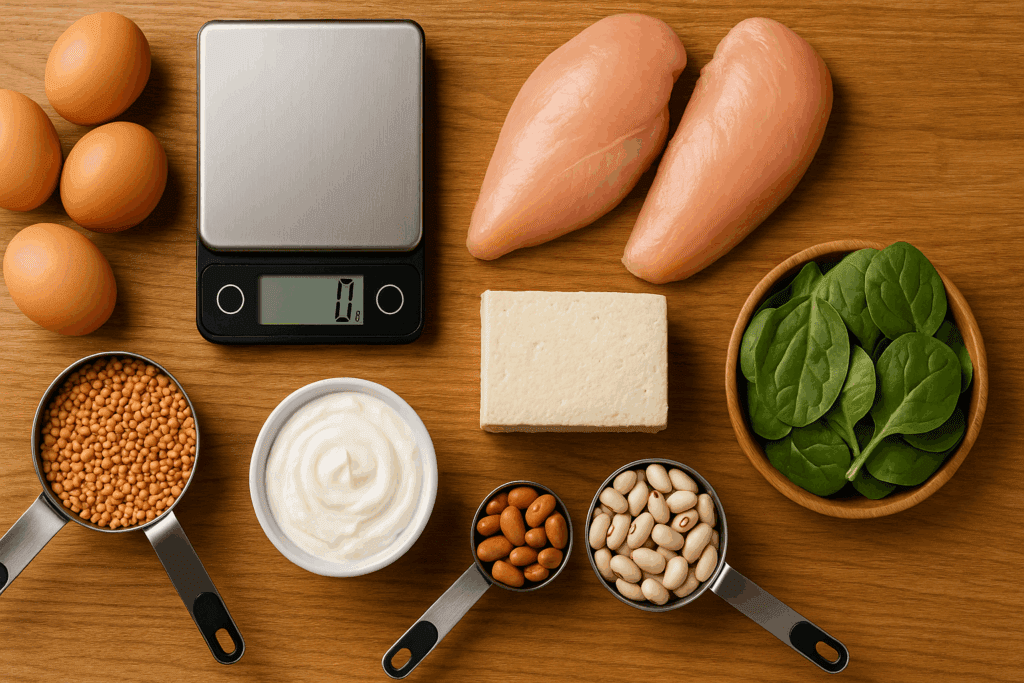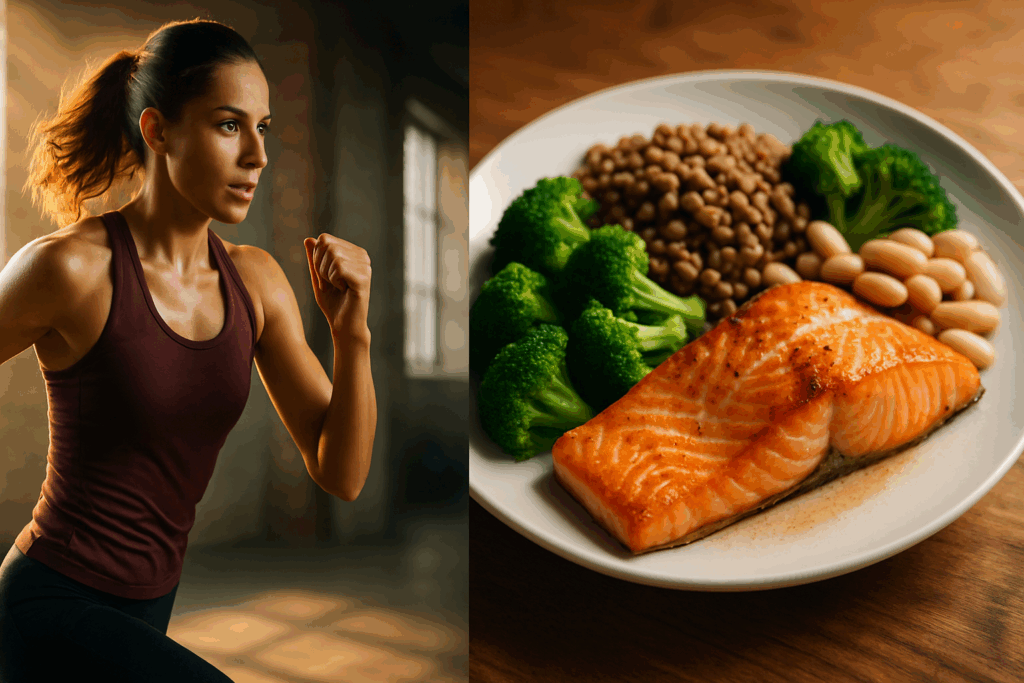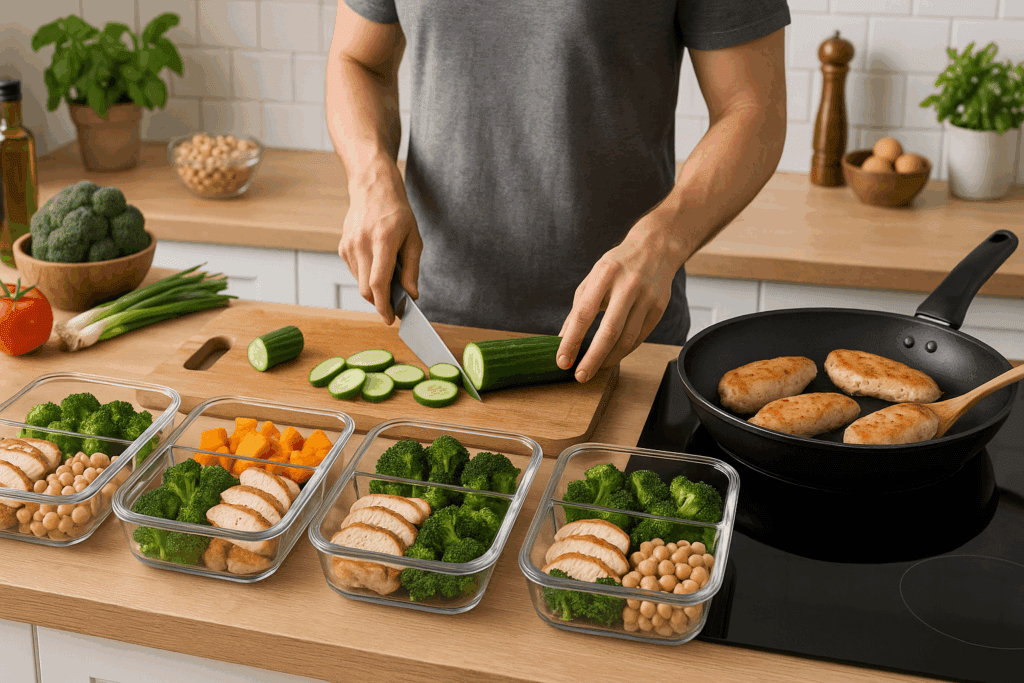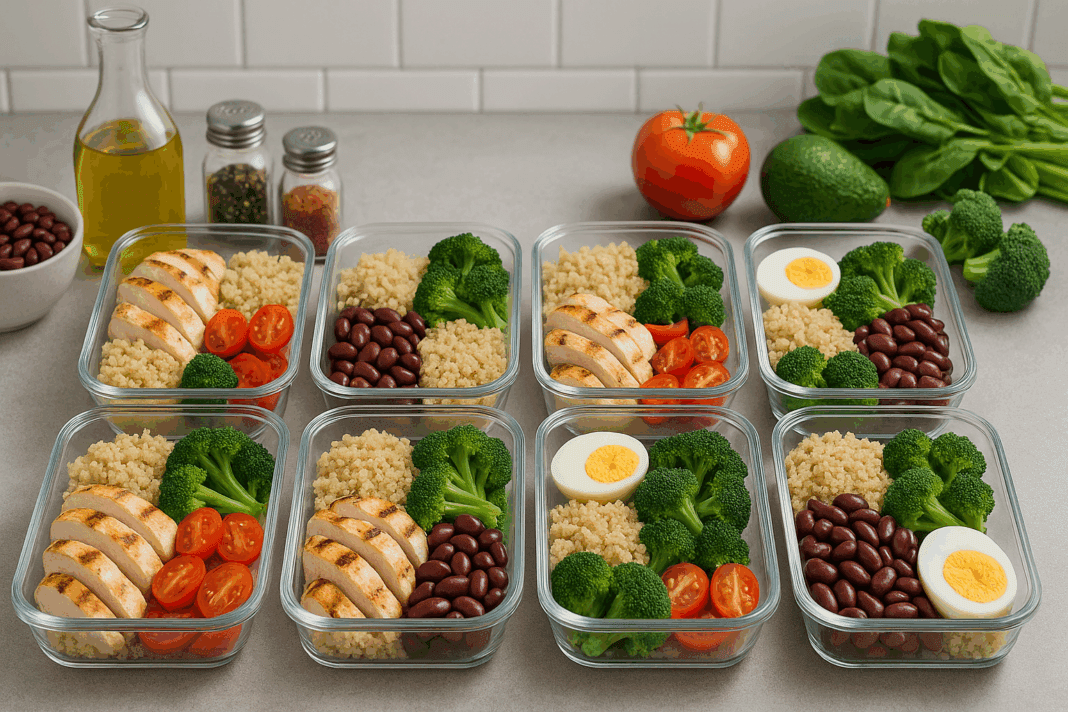In today’s fast-paced world, eating healthy can feel like an overwhelming challenge, particularly for those juggling work, family, and social obligations. However, high protein meal prep is emerging as one of the most efficient strategies for individuals looking to eat nutritiously, shed excess weight, and maintain their energy throughout the day. By mastering a few essential techniques, even the busiest people can implement easy high protein meal prep routines that are both sustainable and enjoyable. The benefits go far beyond convenience; strategically preparing meals in advance promotes mindful eating, reduces impulsive food decisions, and helps maintain a balanced, high protein diet that supports long-term health.
You may also like: Smart Meal Prep Ideas for a Low Carb Diet: Sustainable Strategies for Weight Loss and Lasting Energy
Why High Protein Meal Prep Matters
Protein is an essential macronutrient that plays a critical role in muscle repair, immune function, hormone regulation, and metabolic support. In the context of weight management and metabolic health, high protein meals for weight loss have proven particularly effective. Numerous studies suggest that diets higher in protein can enhance satiety, reduce overall calorie intake, and help preserve lean muscle mass during weight loss efforts. These physiological benefits make protein meal prep not just a fitness trend but a foundational approach to nutritional wellness.
Meal prepping empowers individuals to control portion sizes and nutrient content, both of which are critical for those aiming to lose weight or maintain a healthy lifestyle. When meals are thoughtfully designed to include a consistent amount of high-quality protein, the result is a more stable blood sugar response, reduced cravings, and improved energy levels throughout the day. As such, high protein food prep is not only convenient but instrumental in reinforcing healthy dietary patterns.

The Science Behind High Protein Meals for Weight Loss
The metabolic advantages of protein-rich diets are rooted in their thermogenic effects and ability to preserve lean muscle. Protein has a higher thermic effect than fats or carbohydrates, meaning the body uses more energy to digest and metabolize it. This contributes to an increase in total daily energy expenditure, making high protein recipes for weight loss highly effective. Moreover, by promoting satiety, these meals can naturally curb overeating, allowing individuals to stay within caloric limits without constant hunger.
When incorporated into a calorie-controlled meal prep routine, protein-rich dishes help maintain muscle mass during weight loss. This is especially important because muscle is metabolically active tissue that contributes significantly to resting energy expenditure. Thus, high protein diet meal prep not only supports short-term weight loss but also enhances long-term metabolic health and weight maintenance. By integrating these meals into a consistent meal plan, individuals can optimize body composition and foster a healthier relationship with food.
Practical Benefits of High Protein Meal Prep
Meal prep offers tangible benefits that go far beyond nutrition. For busy professionals, high protein lunch meal prep saves time during hectic weekdays, reducing the need for spontaneous fast-food runs or reliance on processed convenience meals. Financially, recipes for meal prep high protein low cost allow individuals to maximize grocery budgets, minimize food waste, and avoid costly takeout or delivery options. Furthermore, cooking in batches creates an opportunity to experiment with new ingredients and techniques, making mealtime more engaging and less repetitive.
Meal prepping also supports emotional well-being by minimizing the stress and decision fatigue associated with daily meal choices. Having ready-to-eat high protein meals eliminates the guesswork and makes it easier to stay aligned with personal health goals. When meals are preplanned and portioned, individuals are less likely to make impulsive dietary choices driven by hunger or fatigue. This proactive approach to eating reinforces discipline and empowers individuals to make choices based on long-term wellness, rather than short-term cravings.

Smart Strategies for Getting Started with High Protein Food Prep
Transitioning to a meal prep lifestyle doesn’t require a culinary degree or hours in the kitchen. It begins with planning and simple routines that can be scaled up over time. The first step is to choose a few core high protein meal prep ideas that align with personal taste preferences and dietary goals. Rotating between lean proteins such as chicken breast, turkey, tofu, lentils, and eggs provides variety and ensures adequate nutrient intake.
Batch cooking staple ingredients like grains, legumes, and vegetables makes assembly fast and efficient. These base items can be mixed and matched to create diverse high protein dinner meal prep options throughout the week. Preparing sauces, marinades, and spice blends in advance also saves time and enhances flavor without adding excess calories. Those new to the process should start with easy meal prep recipes high protein in nature and gradually experiment with more complex dishes as confidence grows.
Meal Prep Containers and Storage for Success
The right storage containers are essential for keeping meals fresh and safe. Opting for BPA-free, microwave-safe containers with airtight seals can preserve texture and flavor. Clear containers make it easy to identify contents quickly, and portion-sized compartments support balanced meals that include a source of protein, complex carbohydrates, and vegetables. For those on the go, investing in insulated lunch bags or cooler packs can ensure high protein lunch prep stays safe and appetizing.
Refrigeration and freezing strategies are also crucial for effective protein meal prep. Most high protein meals stay fresh in the refrigerator for three to four days, while cooked proteins can last up to three months in the freezer if stored properly. Labeling containers with dates and contents helps maintain organization and reduces the likelihood of waste. This systematic approach fosters a sense of routine and removes the mental burden of daily cooking.

Budget-Friendly Tips for High Protein Meal Prep
Many people assume that high protein meal prep for weight loss must be expensive, but with strategic planning, it can be remarkably cost-effective. Shopping seasonal produce, buying protein sources in bulk, and choosing affordable staples like eggs, beans, and canned fish can keep costs low. For example, canned salmon or tuna offer nutrient-dense, shelf-stable alternatives to fresh fish, while also making for quick protein packed meal prep dishes.
Coupons, loyalty programs, and bulk bins can further reduce expenses without compromising nutritional value. Preparing recipes for meal prep high protein low cost also involves using versatile ingredients that can be repurposed in multiple dishes. For instance, grilled chicken can be used in salads, wraps, and grain bowls, maximizing efficiency and minimizing waste. Smart budgeting and mindful purchasing go hand-in-hand with healthy meal prep ideas high protein in focus.
Creating Variety in Your Weekly Protein Meal Prep
A common misconception about meal prep is that it leads to boring, repetitive meals. On the contrary, incorporating diverse flavors and cuisines can make meal prep exciting and enjoyable. By exploring international recipes and different cooking methods, individuals can keep their taste buds engaged while still meeting their nutritional needs. High protein dinner ideas for weight loss, such as Mediterranean chicken bowls, Asian-inspired tofu stir-fries, or Indian spiced lentil soups, offer flavorful diversity while adhering to dietary goals.
Using herbs, spices, and low-calorie sauces can transform basic ingredients into restaurant-quality dishes. Incorporating seasonal fruits and vegetables not only enhances taste but also provides a rotating nutrient profile that supports overall wellness. Those seeking inspiration can explore social media, food blogs, or cookbooks dedicated to high protein meal prep ideas to discover new favorites and keep their routines fresh.

Balancing Macronutrients for Optimal Energy and Weight Loss
Although protein is the cornerstone of a high protein diet meal prep strategy, it’s important to balance meals with appropriate portions of complex carbohydrates and healthy fats. Carbohydrates such as quinoa, brown rice, and sweet potatoes provide energy and fiber, while fats from avocados, olive oil, and nuts contribute to satiety and nutrient absorption. A well-balanced plate promotes better blood sugar control and sustained energy, especially when paired with high protein lunch meal prep during busy afternoons.
Including a variety of macronutrients in meal prep ensures that meals are not only satisfying but also nutritionally complete. For those aiming for weight loss, adjusting portion sizes and emphasizing high protein low fat meal prep options can further optimize results. The key lies in finding a macronutrient balance that supports both individual health goals and lifestyle needs without sacrificing flavor or satisfaction.
Best High Protein Meal Prep Recipes to Try This Week
High protein recipes for weight loss can be both delicious and accessible, even for beginner cooks. Options like turkey and quinoa stuffed peppers, grilled salmon with roasted vegetables, and egg white muffins with spinach and feta are simple to prepare yet rich in flavor. For lunch, chicken Caesar wraps, chickpea salad bowls, and Greek yogurt chicken salad offer satisfying high protein lunch prep choices that travel well.
For dinner, options such as baked tofu with stir-fried veggies, ground turkey zucchini boats, and shrimp with garlic cauliflower rice provide hearty and healthful meals that support weight management. These meal prep meals high protein in focus are not only easy to batch cook but also designed to freeze or refrigerate well. Adapting favorite comfort foods into healthy protein meal prep versions, such as cauliflower mac and cheese with added chicken, makes staying on track feel indulgent rather than restrictive.
Navigating Meal Prep with Dietary Restrictions
Individuals with dietary restrictions can still enjoy the benefits of protein meal prep recipes tailored to their needs. For vegetarians, protein-rich foods like lentils, chickpeas, tempeh, and eggs serve as excellent staples. Vegan options may include edamame, seitan, quinoa, and tofu. Those managing gluten intolerance can rely on gluten-free grains such as rice and millet, while individuals avoiding dairy can choose plant-based yogurts and cheeses.
It’s essential to read labels carefully and plan meals that avoid allergens or irritants while still meeting protein requirements. With proper planning, healthy high protein meal prep can be adapted to nearly any dietary preference. There are endless lunch meal prep ideas high protein in focus that accommodate various eating styles without compromising nutritional quality or taste. Personalizing prep to suit unique dietary needs promotes consistency and enjoyment over time.
Sustaining Long-Term Success with Meal Prep Habits
The long-term success of any dietary habit lies in its sustainability. Meal prep becomes a lifestyle when it evolves into a consistent, flexible routine that adapts to changing needs. Building a habit begins with setting realistic goals and gradually increasing complexity as skills and confidence grow. Instead of preparing every meal for the week upfront, some may begin with one or two protein lunch meal prep dishes and expand as they become more comfortable.
Accountability, whether through a meal planning app, a prep buddy, or scheduled prep times, helps maintain momentum and track progress. Regularly revisiting personal health goals and updating meal prep strategies accordingly ensures continued motivation. Whether someone is looking to maintain weight, build muscle, or simply eat better, simple high protein meal prep remains one of the most effective tools for achieving those outcomes.
Maximizing Nutritional Value in Every Bite
To get the most out of high protein meal prep, focusing on nutrient density is key. This means choosing whole foods that offer a broad spectrum of vitamins, minerals, and phytonutrients alongside protein. Lean meats, legumes, whole grains, and fresh produce form the cornerstone of healthy protein meal prep strategies. Fortifying meals with superfoods such as leafy greens, berries, chia seeds, or flaxseeds further enhances their health-promoting properties.
Preparation methods also impact nutritional outcomes. Steaming, baking, and grilling are preferable to frying, as they preserve nutrients while minimizing unhealthy fat content. Meal prep meals high protein in design should also minimize added sugars, sodium, and processed ingredients to align with whole-food principles. By prioritizing quality and preparation techniques, each meal becomes an opportunity to nourish the body, fuel productivity, and foster long-term wellness.

Frequently Asked Questions: Healthy High Protein Meal Prep
What are some unexpected benefits of incorporating high protein meal prep into a busy lifestyle?
Beyond time savings and improved nutrition, one of the lesser-known advantages of high protein meal prep is its ability to foster behavioral consistency and emotional regulation. By having structured meals ready, individuals are less susceptible to decision fatigue, which can impair self-control and lead to impulsive eating. This structure helps reinforce positive habits not just around food, but across other areas of life like sleep, productivity, and physical activity. Moreover, the predictability of protein-packed meals helps maintain stable blood sugar levels, which has been linked to better mood and reduced anxiety. As a holistic lifestyle tool, protein meal prep nurtures a sense of control and self-efficacy, especially for those managing chronic conditions or high-stress schedules.
How can someone make high protein meals for weight loss more sustainable in the long term?
Sustainability in high protein meals for weight loss relies heavily on avoiding dietary monotony and maintaining flexibility. A great strategy is to prepare two to three core protein sources, like grilled chicken, baked tofu, and lentil patties, and rotate them across different dishes throughout the week using varying herbs, spices, and global cooking techniques. This keeps meals interesting without significantly increasing prep time. Furthermore, integrating occasional indulgent flavors—like peanut sauce or curry paste—in healthy proportions helps reduce the psychological pressure of restriction. By viewing healthy high protein meal prep as a modular system rather than a rigid plan, individuals are more likely to maintain consistency and enjoy their meals over the long haul.
What are the best ways to adjust high protein meal prep ideas for different fitness goals like bulking or cutting?
When tailoring high protein meal prep ideas for specific fitness goals, macronutrient distribution becomes the key differentiator. For those aiming to bulk, meals should emphasize calorie-dense but nutrient-rich ingredients like quinoa, avocado, nuts, and olive oil in addition to lean protein sources. In contrast, individuals cutting body fat should focus on high protein low fat meal prep options that utilize vegetables and high-fiber carbs like lentils and cauliflower rice to provide volume without excess calories. Portioning is also critical: pre-measuring ingredients with kitchen scales ensures consistency. While both strategies rely on a foundation of protein meal prep recipes, the layering of fats and carbohydrates around that protein shifts based on the intended physique outcome.
How can someone make high protein lunch meal prep more appealing for children or picky eaters?
Transforming high protein lunch meal prep into kid-friendly fare requires creativity and an understanding of preferred textures and flavors. Bento-style meal boxes allow for visual variety and the ability to separate components, which can be more appealing for picky eaters. Introducing dips like hummus, Greek yogurt ranch, or nut butter can enhance both the palatability and protein content of meals. Additionally, reshaping traditional comfort foods with high protein alternatives—like turkey meatballs, black bean quesadillas, or egg muffins—can bridge the gap between familiar flavors and nutritional upgrades. The key lies in maintaining variety, using finger foods, and presenting meals in a colorful and engaging way while still adhering to the principles of healthy high protein meal prep.
What kitchen tools or appliances make protein meal prep more efficient and enjoyable?
Streamlining protein meal prep is easier with a few strategic kitchen tools. An air fryer can dramatically cut down cooking time for meats and vegetables while retaining crisp textures with minimal oil. Pressure cookers like the Instant Pot excel at preparing large batches of beans, grains, and stews, which are staples in many high protein food prep routines. A high-quality digital food scale helps ensure accurate macro tracking, especially for those following structured plans like high protein diet meal prep. Other useful items include a sharp chef’s knife for faster chopping, non-stick sheet pans for batch baking, and divided meal containers for organized storage. These tools not only enhance efficiency but make the process more enjoyable and professional.
Are there any strategies for reducing food waste during high protein meal prep for weight loss?
Reducing waste during high protein meal prep for weight loss starts with proper planning and storage. First, designing a weekly menu that strategically reuses ingredients—such as spinach in omelets, salads, and wraps—minimizes leftover spoilage. Freezing excess portions in labeled containers helps extend shelf life without compromising quality. Cooking in smaller, more frequent batches also allows adjustments based on actual consumption patterns. For perishable protein sources like fish or fresh tofu, it’s best to cook those early in the week and rely on longer-lasting proteins, such as lentils and canned beans, later. Using recipes for meal prep high protein low cost further ensures budget-conscious choices that reduce over-purchasing and unnecessary waste.
What psychological or behavioral advantages come with a consistent protein meal prep habit?
Establishing a routine around high protein meal prep provides psychological stability and enhances decision-making discipline. The predictability of having balanced meals readily available supports emotional regulation, especially during stressful or emotionally taxing periods. Research has shown that routine-based eating patterns can improve body image and reduce disordered eating behaviors. When individuals engage in easy high protein meal prep each week, it also reinforces a growth mindset by demonstrating personal agency over health outcomes. Over time, this consistent habit can elevate confidence and serve as a gateway behavior to other positive lifestyle shifts, such as regular exercise or better sleep hygiene.
How can someone with limited cooking skills get started with healthy protein meal prep?
For those intimidated by cooking, the best approach is to start with simple high protein meal prep recipes that require minimal steps and ingredients. Sheet pan meals, slow cooker stews, and overnight oats with protein powder are great starting points. Choosing high protein meal prep ideas that rely on familiar ingredients—like eggs, canned beans, or pre-cooked chicken—can help reduce the learning curve. Watching step-by-step videos or subscribing to beginner-friendly meal prep services can build confidence over time. Eventually, even novices can scale up to more complex protein packed meal prep routines, especially when they recognize the financial and health-related advantages.
Can high protein dinner ideas for weight loss be optimized for late-night eating?
Absolutely. Late-night meals can still be nutritious and aligned with weight loss goals when they prioritize satiety without heaviness. High protein dinner ideas for weight loss should include easily digestible proteins like cottage cheese, eggs, or baked white fish paired with steamed vegetables or a small serving of quinoa. Avoiding high-fat sauces and refined carbohydrates can reduce nighttime indigestion and promote better sleep. It’s also helpful to keep portions moderate and eat at least one to two hours before bedtime. By integrating easy meal prep recipes high protein in content and tailored to circadian needs, late-night meals can become an asset rather than a dietary pitfall.
How do you maintain flavor and texture in high protein lunch prep over several days?
Maintaining the appeal of meal prep meals high protein in structure requires attention to ingredient selection and storage methods. Use moisture-resistant veggies like bell peppers, carrots, and green beans that hold up well over time. Store sauces separately and add them just before eating to prevent sogginess. Grains such as farro or barley retain texture better than softer options like white rice. When preparing protein lunch meal prep in advance, marinating proteins before cooking can preserve juiciness and deepen flavor. Rotating flavors every three to four days and using airtight, compartmentalized containers can extend both taste and freshness across the week.

Reflecting on the Power of High Protein Meal Prep for Sustainable Wellness
The journey toward better health doesn’t require extreme dieting or exhaustive willpower. Instead, it begins with simple, intentional choices—and high protein meal prep stands as one of the most accessible and impactful ways to take control of personal nutrition. By planning ahead, embracing variety, and balancing cost with quality, individuals can create sustainable eating habits that support weight loss, improve energy, and enhance overall quality of life.
What sets high protein meal prep apart is its ability to blend convenience with customization, allowing each person to align their meals with unique goals, preferences, and schedules. Whether someone is preparing healthy meal prep ideas high protein in nature for the first time or refining a seasoned routine, the act of cooking in advance promotes mindfulness, accountability, and confidence in the kitchen. As health trends continue to evolve, one principle remains clear: consistent, thoughtful preparation is the cornerstone of long-term well-being.
For those ready to start, the best high protein meal prep strategy is the one that fits seamlessly into everyday life. It’s not about perfection, but about progress—choosing meals that nourish, empower, and support your health goals with every bite. As with any wellness journey, patience, experimentation, and self-compassion are the true ingredients for lasting success.
Further Reading:
57 Meal Prep Recipes For Muscle Building & Fat Loss

